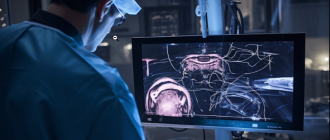 Gallbladder Ultrasound for Specific Patient Populations: A Comprehensive Guide
Gallbladder Ultrasound for Specific Patient Populations: A Comprehensive Guide
Gallbladder ultrasound is a non-invasive imaging technique that uses sound waves to create images of the gallbladder. It is commonly used to diagnose and monitor conditions affecting the gallbladder, such as gallstones, gallbladder inflammation, and gallbladder cancer. While gallbladder ultrasound is a safe and effective diagnostic tool for most patients, there are certain special patient groups that require additional considerations.
Pregnant women are one such special patient group. Ultrasound is generally considered safe during pregnancy, as it does not use ionizing radiation. However, precautions should still be taken to minimize any potential risks to the fetus. In the case of gallbladder ultrasound, the sonographer will use a lower power setting and limit the duration of the examination to reduce exposure to the developing fetus.
Another special patient group that may require special considerations for gallbladder ultrasound is children. Pediatric patients may have difficulty staying still during the examination, which can affect the quality of the images. To overcome this challenge, the sonographer may use techniques such as distraction or sedation to ensure a successful examination. Additionally, the equipment used for pediatric gallbladder ultrasound may be smaller in size to accommodate the smaller body size of children.
Patients who are obese or have a large body habitus may also require special considerations for gallbladder ultrasound. The increased amount of adipose tissue can make it more difficult to visualize the gallbladder and surrounding structures. In these cases, the sonographer may need to use additional techniques, such as adjusting the depth and focus of the ultrasound beam, or using a higher frequency transducer to improve image quality.
Overall, gallbladder ultrasound is a valuable diagnostic tool for a wide range of patients. However, special patient groups such as pregnant women, children, and obese individuals may require additional considerations to ensure a successful examination and accurate diagnosis.
During Pregnancy
Pregnant women commonly undergo gallbladder ultrasound to assess the presence of gallstones or other abnormalities that may cause symptoms such as abdominal pain or discomfort. However, ultrasound imaging during pregnancy requires special considerations to ensure the safety of both the mother and the developing fetus.
When performing a gallbladder ultrasound on a pregnant woman, the sonographer will take precautions to minimize the exposure of the fetus to ultrasound waves. The ultrasound machine will be set to the lowest possible power settings while still obtaining diagnostic images. Additionally, the sonographer will focus the ultrasound beam specifically on the gallbladder area, avoiding unnecessary exposure to other areas of the abdomen.
It is important to note that gallbladder ultrasound is generally considered safe during pregnancy, as it does not use ionizing radiation like X-rays or CT scans. However, as with any medical procedure, the benefits and risks should be carefully considered. The healthcare provider will weigh the potential benefits of the ultrasound in diagnosing and managing gallbladder conditions against any potential risks to the fetus.
In some cases, the healthcare provider may recommend postponing the gallbladder ultrasound until after the pregnancy, especially if the symptoms are mild and not affecting the overall health of the mother or baby. However, if the symptoms are severe or there is concern for complications, a gallbladder ultrasound may be necessary during pregnancy.
During the ultrasound procedure, the pregnant woman will be positioned comfortably on an examination table. The sonographer will apply a clear gel to the abdomen to help the ultrasound transducer make smooth contact with the skin. The transducer will be gently moved over the abdomen to capture images of the gallbladder and surrounding structures.
After the gallbladder ultrasound, the images will be reviewed by a radiologist or healthcare provider. They will interpret the findings and determine if further testing or treatment is necessary. The results will be discussed with the pregnant woman, taking into consideration her unique situation and any potential impact on the pregnancy.
Gallbladder ultrasound can be performed during pregnancy with appropriate precautions to ensure the safety of the mother and fetus. The decision to proceed with the procedure should be based on the individual circumstances and the potential benefits outweighing any potential risks. Healthcare providers will carefully evaluate the need for a gallbladder ultrasound and provide guidance accordingly.
Is It Safe?
One of the main concerns when performing a gallbladder ultrasound on special patient groups is safety. It is important to ensure that the procedure does not pose any risks or harm to the patient.
Fortunately, gallbladder ultrasounds are considered to be a safe and non-invasive imaging technique. The procedure uses sound waves to create images of the gallbladder and surrounding structures, without the need for radiation or contrast agents.
However, certain precautions may need to be taken for specific patient groups. For example, in pregnant women, the ultrasound technician will need to adjust the positioning and technique to ensure the safety of both the mother and the fetus. In patients with known allergies or sensitivities to ultrasound gel, alternative options can be explored.
It is also essential for the ultrasound technician to properly explain the procedure to the patient and address any concerns or questions they may have. This can help alleviate anxiety and ensure the patient feels comfortable throughout the examination.
Gallbladder ultrasounds are generally considered safe for special patient groups. However, it is important to take into account the specific needs and conditions of these patients to ensure their safety and well-being during the procedure.
Benefits vs Risks
When considering the use of gallbladder ultrasound for special patient groups, it is important to weigh the benefits against the potential risks. Here is a table outlining some of the key benefits and risks associated with this procedure:
| Benefits | Risks |
| Non-invasive procedure | Minimal risk of complications |
| No exposure to ionizing radiation | Possible false positive or false negative results |
| Can help diagnose gallbladder diseases | Potential discomfort or pain during the procedure |
| Can guide further treatment decisions | May not be suitable for patients with certain medical conditions |
| Can be performed on pregnant women | May not provide a definitive diagnosis in all cases |
It is important for healthcare providers to carefully consider these benefits and risks when determining whether gallbladder ultrasound is appropriate for special patient groups. In some cases, alternative imaging modalities or diagnostic procedures may be more suitable, depending on the individual patient’s medical history and specific needs.
Alternative Tests
While ultrasound is the preferred method for evaluating the gallbladder, there are alternative tests that may be used in special patient groups or when ultrasound is not possible or inconclusive.
Computed tomography (CT) scan: This imaging test uses X-rays and computer technology to create detailed images of the gallbladder. It can be useful in patients who have a high body mass index (BMI) or who are unable to undergo an ultrasound.
Magnetic resonance imaging (MRI): MRI uses a magnetic field and radio waves to produce detailed images of the gallbladder. It is helpful in patients who cannot tolerate CT scan or have contraindications to CT contrast agents.
Hepatobiliary iminodiacetic acid (HIDA) scan: This test involves injecting a radioactive tracer into the bloodstream, which is taken up by the liver and excreted into the bile. A special camera is used to track the flow of the tracer and evaluate the gallbladder function.
Endoscopic retrograde cholangiopancreatography (ERCP): This is a procedure that combines endoscopy and X-rays to visualize the gallbladder and the bile ducts. It is mainly used to diagnose and treat conditions affecting the bile ducts, but can also provide information about the gallbladder.
It is important to note that these alternative tests may have limitations and risks, and should be used judiciously based on the individual patient’s needs and circumstances. Your healthcare provider will determine the most appropriate test for you.
For Pediatric Patients
Ultrasound is a safe and effective imaging technique for evaluating the gallbladder in pediatric patients. It is non-invasive and does not use ionizing radiation, making it ideal for use in children.
When performing a gallbladder ultrasound on pediatric patients, there are a few key considerations to keep in mind:
| Patient Preparation | Pediatric patients may require additional preparation to ensure a successful ultrasound examination. This may include fasting for a certain period of time prior to the procedure. |
| Equipment | It is important to use age-appropriate ultrasound equipment when imaging pediatric patients. Smaller probes and lower frequency settings may be necessary to obtain clear images. |
| Technique | The technique for performing a gallbladder ultrasound on pediatric patients is similar to that used for adult patients. However, the sonographer should be prepared to adapt the technique based on the child’s size and cooperation level. |
| Communication | Effective communication with the child and their parents is essential during the ultrasound examination. The sonographer should explain the procedure in a child-friendly manner and maintain a calm and reassuring demeanor. |
| Sedation | In some cases, pediatric patients may require sedation to ensure cooperation during the ultrasound examination. This should be administered by a qualified healthcare professional in a safe and controlled environment. |
Overall, gallbladder ultrasound is a valuable diagnostic tool for evaluating pediatric patients. It allows for the visualization of the gallbladder and surrounding structures, helping to identify any abnormalities or conditions that may be present.
Minimum Recommended Age
The minimum recommended age for a gallbladder ultrasound varies depending on the specific situation and the patient’s medical history.
In general, gallbladder ultrasounds are not routinely performed on infants and very young children unless there is a specific medical indication. Ultrasound imaging may be more challenging in this age group due to their small size and limited ability to cooperate.
For older children and adolescents, gallbladder ultrasounds can be performed if there is a suspected issue with the gallbladder, such as gallstones or inflammation. The minimum recommended age in these cases is typically around 5 years old.
For adults, there is no specific minimum recommended age for a gallbladder ultrasound. The decision to perform the procedure is based on the patient’s symptoms, medical history, and the doctor’s clinical judgment.
It is important to note that individual circumstances may vary, and the ultimate decision regarding the appropriate age for a gallbladder ultrasound should be made by a qualified healthcare professional.
Preparing Your Child
Preparing your child for a gallbladder ultrasound can help them feel less anxious and more comfortable during the procedure. Here are some steps you can take to prepare your child:
- Explain the procedure: Talk to your child about why they need the ultrasound and what to expect during the procedure. Use simple and age-appropriate language to help them understand.
- Address their concerns: Listen to any concerns or fears your child may have about the ultrasound. Reassure them that the procedure is safe and painless.
- Provide support: Let your child know that you will be there with them during the procedure. Offer comfort and encouragement to help them feel more at ease.
- Dress comfortably: Have your child wear loose and comfortable clothing on the day of the ultrasound. This will make it easier for the technician to access the area being examined.
- Follow fasting instructions: Depending on the type of ultrasound being performed, your child may need to fast before the procedure. Make sure to follow any fasting instructions given by the healthcare provider.
- Bring distractions: To help your child stay occupied during the procedure, bring along their favorite toys, books, or electronic devices.
- Ask questions: If you have any questions or concerns about the ultrasound, don’t hesitate to ask the healthcare provider. They will be happy to provide you with the information you need.
By taking these steps to prepare your child, you can help create a positive experience for them during their gallbladder ultrasound.
Procedure Adjustments
Performing a gallbladder ultrasound on special patient groups may require certain adjustments to the standard procedure. These adjustments help accommodate the specific needs or limitations of these patients, ensuring a safe and effective examination.
Some common adjustments include:
| Special Patient Group | Procedure Adjustment |
| Pediatric patients | Use a smaller transducer to ensure comfort and safety for the child. Consider using distraction techniques or involving a parent or caregiver to help keep the child calm during the procedure. |
| Pregnant patients | Take extra precautions to minimize exposure to ultrasound waves. Use the lowest possible power settings and limit the duration of the exam. Position the patient comfortably to avoid any discomfort or pressure on the abdomen. |
| Obese patients | Adjust the depth and focus settings to obtain clear images through the extra layers of adipose tissue. Use a larger transducer if necessary. Take extra care to ensure proper contact between the transducer and the patient’s skin. |
| Elderly patients | Consider any mobility or cognitive limitations of the patient. Take extra time to position the patient comfortably and explain the procedure clearly. Use a supportive pillow or cushion to provide additional comfort during the examination. |
It is important for sonographers to be familiar with these procedure adjustments and to adapt their technique accordingly. By doing so, they can ensure a successful and comfortable gallbladder ultrasound for special patient groups.
For Geriatric Patients
Gallbladder ultrasound is a safe and effective diagnostic tool for geriatric patients. As individuals age, they may be more likely to experience gallbladder-related issues such as gallstones or gallbladder inflammation. Ultrasound can help to identify these issues and guide further treatment.
When performing a gallbladder ultrasound on geriatric patients, there are a few important considerations to keep in mind:
- Patient positioning: Geriatric patients may have mobility issues or difficulty maintaining certain positions during the ultrasound. It is important to ensure that the patient is comfortable and able to stay still throughout the procedure.
- Image interpretation: Age-related changes in the gallbladder, such as increased wall thickness or the presence of gallstones, may be more common in geriatric patients. Radiologists should be aware of these changes and consider them when interpreting ultrasound images.
- Collaboration with other healthcare providers: Geriatric patients often have multiple healthcare providers involved in their care. It is important to communicate any findings from the gallbladder ultrasound with the patient’s primary care physician or other relevant specialists to ensure appropriate follow-up care.
Gallbladder ultrasound is a valuable tool for diagnosing and managing gallbladder issues in geriatric patients. By considering the unique needs of this patient population, healthcare providers can ensure that they receive the best possible care.
Importance of Screening
Screening for gallbladder issues is of utmost importance, especially in special patient groups. The gallbladder is a small organ located beneath the liver that plays a crucial role in the digestive process. It stores bile produced by the liver and releases it into the small intestine to aid in the digestion of fats.
Regular screening for gallbladder conditions can help identify potential problems early on, allowing for prompt intervention and treatment. This is especially important for special patient groups, such as those with a family history of gallbladder issues, individuals with a high body mass index (BMI), and patients with certain medical conditions like diabetes or liver disease.
Benefits of Screening:
| 1. Early detection of gallstones or other abnormalities. |
| 2. Prevention of complications, such as gallbladder inflammation or infection. |
| 3. Prompt treatment to alleviate symptoms and improve quality of life. |
| 4. Monitoring of existing gallbladder conditions to prevent further complications. |
By undergoing regular gallbladder ultrasound screenings, individuals in special patient groups can stay proactive in their health management and potentially avoid more serious issues in the future. It is important to consult with a healthcare professional to determine the appropriate screening frequency and any additional measures that may be necessary based on individual risk factors.
Mobility Considerations
When performing a gallbladder ultrasound on special patient groups, mobility considerations are important to ensure patient comfort and safety. These considerations include:
| Consideration | Explanation |
| Wheelchair Accessibility | Ensure that the ultrasound room is wheelchair accessible, with ramps or elevators available if needed. This will allow patients with mobility aids to easily enter and exit the room. |
| Comfortable Seating | Provide comfortable seating options for patients who may have difficulty standing for long periods of time. This can include chairs with back support or cushions to alleviate discomfort. |
| Assistance for Transfers | Offer assistance to patients who may require help with transferring from a wheelchair to the ultrasound table. This may involve providing staff members who are trained in safe patient transfers. |
| Clear Pathways | Ensure that there are clear pathways in the ultrasound room, free from obstacles or clutter. This will allow patients to navigate the space easily and safely, especially those using mobility aids. |
| Accessible Restrooms | Provide accessible restrooms that are equipped with grab bars and other necessary features for patients with mobility needs. This will allow patients to use the restroom before or after the procedure. |
By considering the mobility needs of special patient groups, healthcare providers can create a more inclusive and comfortable environment for gallbladder ultrasound examinations.
Potential Findings
During a gallbladder ultrasound, several potential findings may be observed. These findings can help diagnose various conditions and guide treatment decisions. Some of the potential findings include:
- Gallstones: The presence of gallstones is a common finding during a gallbladder ultrasound. These are small, hard deposits that can form in the gallbladder and can cause pain and inflammation.
- Gallbladder wall thickening: Thickening of the gallbladder wall can be indicative of various conditions, such as inflammation or infection.
- Gallbladder polyps: Polyps are growths that can develop on the inner lining of the gallbladder. While most polyps are benign, they can sometimes be a precursor to gallbladder cancer.
- Dilated bile ducts: Enlargement of the bile ducts can indicate a blockage or obstruction, which may be caused by gallstones or other conditions.
- Biliary sludge: Biliary sludge refers to a mixture of bile, cholesterol, and calcium salts that can accumulate in the gallbladder. It can be a precursor to the formation of gallstones.
- Gallbladder mass or tumor: In rare cases, a mass or tumor may be detected in the gallbladder during an ultrasound. This finding may require further evaluation to determine if it is benign or malignant.
It is important to note that these potential findings may not always be present and that further evaluation may be needed to confirm a diagnosis. Additionally, the interpretation of these findings should be done by a trained healthcare professional.
Question and answer:
What is a gallbladder ultrasound?
A gallbladder ultrasound is a diagnostic procedure that uses sound waves to create images of the gallbladder and surrounding structures.
Why is a gallbladder ultrasound done?
A gallbladder ultrasound is done to evaluate the gallbladder for any abnormalities or conditions such as gallstones, inflammation, or tumors.
How is a gallbladder ultrasound performed?
A gallbladder ultrasound is performed by applying a gel to the abdomen and using a handheld device called a transducer to transmit sound waves through the body. The sound waves bounce off the gallbladder and other structures, creating images that can be viewed on a monitor.
Are there any risks or side effects associated with a gallbladder ultrasound?
A gallbladder ultrasound is a non-invasive and safe procedure with no known risks or side effects.
Can anyone have a gallbladder ultrasound?
Gallbladder ultrasounds can be performed on most individuals, including pregnant women, children, and the elderly. However, certain special patient groups may require additional considerations or modifications to the procedure.
What is a gallbladder ultrasound?
A gallbladder ultrasound is a medical imaging procedure that uses sound waves to create images of the gallbladder. It is a non-invasive and painless procedure that helps doctors diagnose and monitor conditions affecting the gallbladder.
Who should undergo a gallbladder ultrasound?
A gallbladder ultrasound is typically recommended for patients who are experiencing symptoms such as abdominal pain, jaundice, or abnormal liver function tests. It can also be used to monitor known gallbladder conditions or to evaluate the effectiveness of treatment.
Is a gallbladder ultrasound safe for pregnant women?
Yes, a gallbladder ultrasound is considered safe for pregnant women. It does not use ionizing radiation, such as X-rays, and there are no known harmful effects on the fetus. However, it is important to inform the technician and doctor if you are pregnant or suspect you may be pregnant before undergoing the procedure.






